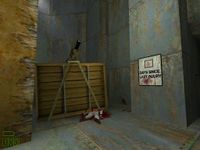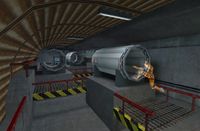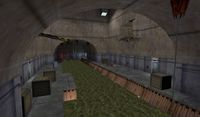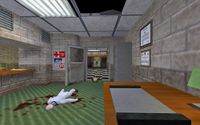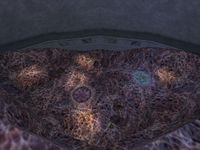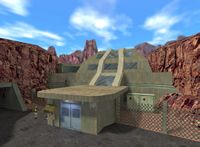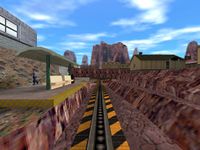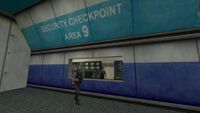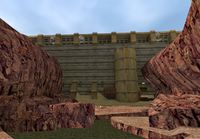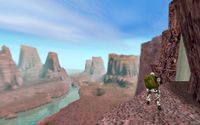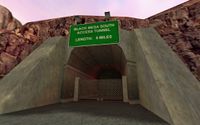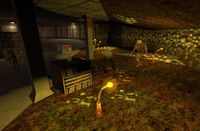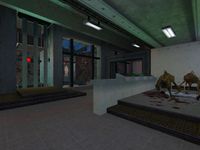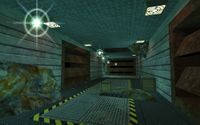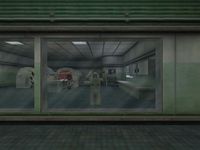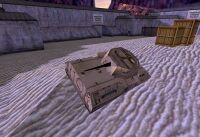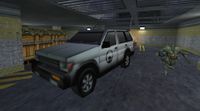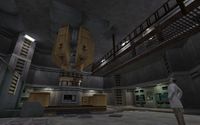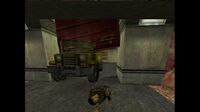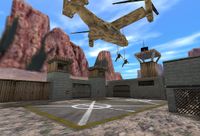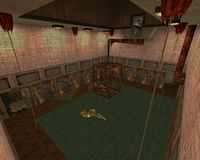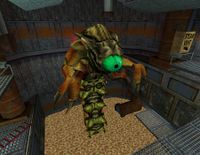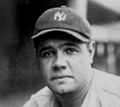Black Mesa Research Facility
For other uses, see Black Mesa (disambiguation). |
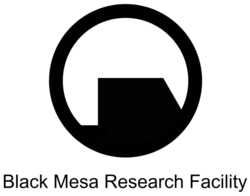
| |
| Black Mesa Research Facility | |
|---|---|
| General information | |
| Constructed |
1950s, then refurbished by Black Mesa before the Black Mesa Incident |
| Destroyed |
200-, during the Black Mesa Incident by federal agents using a nuclear warhead |
| Location | |
| Builder | |
| Usage | |
| Era(s) | |
| Faction | |
- "The biggest embarrassment has been Black Mesa facility, but I think that's finally taken care of itself."
- ― The G-Man[src]
The Black Mesa Research Facility,[1] B.M.R.F.,[2] or Black Mesa for short, is the headquarters of the Black Mesa corporation, and the primary setting for Half-Life and its expansions. It is located in the New Mexico desert, USA.[1]
Contents
- 1 Overview
- 2 Personnel
- 3 The Black Mesa Incident
- 4 Hazards
- 5 Facilities
- 5.1 Main Sectors
- 5.2 Other areas
- 5.2.1 Advanced Biological Research Lab
- 5.2.2 Alien Quarantine Labs
- 5.2.3 Area 7 Recreational Facilities
- 5.2.4 Area 8 Topside Dormitories
- 5.2.5 Area 9
- 5.2.6 Biological Waste Processing Plant
- 5.2.7 Black Mesa Air Control
- 5.2.8 Black Mesa desert
- 5.2.9 Black Mesa South Access
- 5.2.10 Black Mesa Transit System
- 5.2.11 Blast furnaces
- 5.2.12 East Personnel Entrance
- 5.2.13 Freight Yard
- 5.2.14 Gamma Labs
- 5.2.15 Hydrofauna Studies Laboratory
- 5.2.16 Level 1 Main Facility Entrance
- 5.2.17 Level 3
- 5.2.18 Level 4 Storage Unit
- 5.2.19 Medical Lab
- 5.2.20 Ordinance Storage Facility
- 5.2.21 Parking Garage
- 5.2.22 Satellite Communications Center
- 5.2.23 Section A-17 Prototype Labs
- 5.2.24 Storage Areas 2 and 3
- 5.2.25 Topside Motorpool
- 5.2.26 Unnamed Decay location
- 5.2.27 Unnamed industrial area
- 5.2.28 Waste Processing Area 3
- 6 Other notable features
- 7 Behind the scenes
- 8 Gallery
- 9 List of appearances
- 10 References
- 11 External links
Overview[edit]
The Black Mesa facility was apparently built over several decommissioned ICBM launching and testing silo complexes constructed during the 1950s,[3][4][5] which was converted into a vast civilian institute for the research of almost every conceivable scientific discipline, loosely spread along seven main Sectors. Some areas are also described by characters such as Rosenberg as "old" or "abandoned"; several areas of the complex are badly run-down despite the obvious fact that they are still in use. However, the surface areas of Black Mesa feature more modern construction.[1][2][6][7]
Black Mesa's Science Team undertakes the company's various scientific researches in the facility, which is a very high-security complex, as each employee is required to undergo a series of rigorous security checks to access most areas. Security guards, carrying firearms and trained for emergencies, are present everywhere. The complex is also equipped with retinal scanners and alarms, as well as heavy blast doors that may shut down in case of fire, explosion, or other events. Black Mesa can be completely sealed from the outside.[1][2][6][7] In the event of an emergency (such as leaks of dangerous materials, escape of specimens, or even government cleanups), the "military" (the HECU) and in worse cases "trained assassins" (the Black Ops), referred to as "a dangerous and very efficient clean-up crew", are to enter the facility.[8] An intervention from the HECU and the Black Ops seems to be a known fact among the personnel, although some employees consider it a rumor.[1] Black Mesa also contains many automated Automatic Turrets, which, when activated, will emerge from armored cupolas and fire upon any moving object in their line of sight.[1][2]
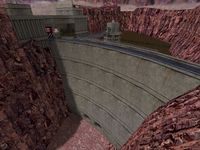
As employees are required to live in the complex itself, Black Mesa contains many personnel facilities, including laundromats,[7] recreation and sports areas such as lounges,[1][2][7] at least one basketball court,[7] at least one swimming pool,[2] a library,[2] fast food outlets,[7] food courts,[1] cafeterias,[1][2] and numerous vending machines. The facility is well-populated by rest areas and dormitories for the employees of the facility.[1][2][7] As Eli Vance reveals at Black Mesa East that his wife and daughter lived in Black Mesa with him, it can be inferred that employees' families reside in the dormitory complexes as well.[9] Despite being located in the middle of a desert, the underground and indoor sectors of Black Mesa are maintained at a "pleasant 68°" Fahrenheit (20° Celsius) at all times,[1] enabled by Black Mesa's sprawling network of ventilation ducts.
The facility is apparently self-sufficient, housing its own ventilation, plumbing, sewage, and power generation systems including a Hydro-Electric Dam[1][6] and multiple types of electrical generators and reactors, some using nuclear technology. Black Mesa is also apparently kept supplied by a conventional freight rail linked to the outside, managed in the Freight Yard.[7]
The complex is dominated by a bewildering number of underground laboratories, test areas (including a powerful Anti-Mass Spectrometer[1]), and administration offices, most of which contain very high-tech equipment, and even a rocket launch site.[1] The complex also features multi-story car parks (where only Black Mesa SUVs can be found), arsenals of nuclear and conventional weapons, and a local electric rail materials transport network, the Sector E Materials Transport.[1][2][6][7]
In the underground laboratories, administration offices and dormitories, the main sections are always indicated in important intersections areas, and follow color codes consisting of lines running along the corridors to the related location, stopping at each reached location. This is seen for instance in the Anomalous Materials Labs[2] and the Level 3 Dormitories.[2]
All main Sectors are linked together by the Black Mesa Transit System, the monorail network going through the whole facility.[1][2][6][7]
Black Mesa is equipped with a public address system, the Black Mesa Announcement System, relaying audible messages and announcements across the facility with a male voice.[1][2][6][7] The complex also has its own newspaper, The Mesa Times, although it is unknown if it is an outside publication or exclusively made by the company for its personnel.[7]
Personnel[edit]
Black Mesa employs in its facility two main groups of civilian employees: a science personnel and a security personnel, along with various other inhabitants including administrative personnel, service personnel and occasionally the employees' families.
The Black Mesa Incident[edit]
Occurring on May 16, 200-,[10] the Black Mesa Incident is caused directly by a failed experiment in Sector C, triggering a Resonance Cascade. This leads to the invasion of the facility by Xen creatures, and finally its complete destruction by a thermonuclear bomb.
Hazards[edit]
The Black Mesa Research Facility, being a science research facility, presents numerous hazards to both health and safety. These can include:
- Electrical hazards, from electrical apparatus and power systems
- Burning/heat hazards, from steam pipes, furnaces or any other hot apparatus
- Freezing hazards, from freezers and super coolants
- Acid / corrosive hazards, from countless acid and alkali chemicals in all different applications
- Radioactive hazards, from nuclear reactors and waste
- Biohazards, from biological waste and residue
- A risk of drowning in extremely deep water basins
- Being harmed/killed by underwater machinery
- A risk of fractures from falling, and/or machinery
Due to so many possible hazards being present in various applications all throughout Black Mesa, precautions must be taken. Certain areas call for the use of safety equipment, others will only allow entry when wearing an HEV Suit, a cleansuit or an armor vest and helmet. This point is backed up by security guards stationed at 'secure access' doors being instructed to only permit access if the entrant is wearing proper equipment.
Black Mesa also features an enormous supply of medical facilities and equipment. There are wall-mounted first aid stations, supplies of portable first aid satchels, infirmary areas. Many scientists are also trained in first aid.
Facilities[edit]
The various Black Mesa facilities are loosely grouped into seven Sectors lettered from A to G, as well as various Areas and Levels, all linked together by the Black Mesa Transit System or Sector E Materials Transport. Many areas visited during the games have no known Sector; it is actually unclear if every single area always belongs to one.
The details about all the Black Mesa area names are given in signs found within the maps, character dialogs, Black Mesa Announcement System announcements and the games' instruction manuals. However many announcements are never heard in-game, only to be found in the file "sentences.txt" located in each game's sound folder, showing that many more messages were originally to be heard during the games. Each sentence has a map name before it, allowing clear identification of the related area.
As many names and details appear in the Gearbox expansions, it is unknown exactly what the Gearbox team came up with, and what was handed to them by Valve. Regardless, the facility was created more to serve gameplay than to be a consistent facility with all sectors and areas fitting perfectly together; this is far from being the case.
Main Sectors[edit]
Sector A[edit]
Encountered in all four of the Half-Life games, Sector A contains the separate Hazard Courses used for training scientists[1] (predominantly in the use of the HEV Suit) and security guards.[7]
Sector B[edit]
The Coolant Reserve located in Sector B apparently stores the industrial coolant used to maintain Black Mesa's thousands of computers and machines. It is first seen by Gordon Freeman when he escapes from Sector C.
Sector C[edit]
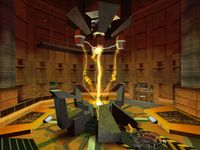
Sector C is notable primarily for housing the Anomalous Materials Laboratories, Gordon Freeman's workplace. This area contains the Anti-Mass Spectrometer (in Test Lab C-33/a), the initial source of the Black Mesa Incident, the starting point of the Half-Life series.
Sector D[edit]
Seen early in Half-Life, Sector D is mainly a large underground complex of Administration Offices where the bureaucratic aspects of Black Mesa's upkeep take place, along with some limited research. It also contains some limited cafeteria facilities, as well as a very large walk-in freezer.
Sector E[edit]
This sector features the Biodome Complex, a relatively recent area of the facility, containing a series of Specimen Observation Areas, where captured Xen aliens and flora are kept and observed in artificial recreations of their natural habitats. Sector E also features the large Materials Transport, Black Mesa's freight monorail, the High Altitude Launch Center, where rockets are launched, as well as a large Ordinance Storage Facility where the Mark IV Thermonuclear Device is set up and the Gene Worm teleports in.
Sector F[edit]
The heavily fortified Lambda Reactor Complex featured in Sector F is the site of Black Mesa's top secret teleportation labs. It features a huge reactor consisting of the Lambda Reactor Coolant System, and the cylindrical Lambda Reactor Core, as well as a large teleport.
Sector G[edit]
Sector G features the Topside Hydro Plant and its iconic Hydro-Electric Dam providing the power for the facility, and the Drainage Canals.
Other areas[edit]
The following areas are either not linked to a specific sector, or their specific sector is unknown.
Advanced Biological Research Lab[edit]
Located near Sector G's Hydro-Electric Dam and partially above the Biological Waste Processing Plant, the Advanced Biological Research Lab cover the Half-Life chapter Questionable Ethics. This is where the Tau Cannon is found.
Alien Quarantine Labs[edit]
Located under the Gamma Labs, aliens brought with the Displacement Beacon are studied there. Cross and Green are sent there by Keller to turn on a beam matrix to power the Displacement Beacon on the surface.[2]
Area 7 Recreational Facilities[edit]
Whilst not seen in the game, a Black Mesa Transit System map featured in Blue Shift mentions Area 7. It is connected to the Green Line of the Black Mesa Transit System.[11]
Area 8 Topside Dormitories[edit]
This area consists of outdoor dormitories where Barney Calhoun is accommodated while working at Black Mesa. A stop on the Black Mesa Transit System leads to the East Personnel Entrance.[7]
Area 9[edit]
Area 9 Central Transit Hub[edit]
Area 9 Central Transit Hub is a hub mentioned in the tram ride at the beginning of Half-Life. It can be seen in the transit map later in Blue Shift. It is apparently the only Transit System station where high-security trains can be boarded.[7]
Area 9 Security Checkpoint[edit]
Likely located not far from Area 9 Central Transit Hub, Area 9 Security Checkpoint is first seen during Barney Calhoun's tram ride at the start of Blue Shift. There, Barney Calhoun transfers to the Sector C Line. Area 9 Security Checkpoint apparently acts as one of the many transit security checkpoints throughout the Transit System. Trams that pass through that checkpoint can be rerouted to the Sector B, C, and E Lines.[7]
Biological Waste Processing Plant[edit]
Visited during the Half-Life chapter Residue Processing, the Biological Waste Processing Plant disposes of and processes Black Mesa's wastes through large tanks and an endless conveyor belt network.[1]
Black Mesa Air Control[edit]
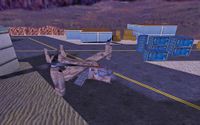
This building is adjacent to a large airstrip, and is used to monitor and direct activity in the airspace above Black Mesa.[2]
Black Mesa desert[edit]
This desert area includes several sandy areas with Land Mines, cacti and rocks, as well as several small HECU camps. There Freeman is chased by the AH-64 Apache that started attacking him at the dam, and finally defeats it when first finding the RPG along a steep cliff in front of a large mesa valley, at the climax of the chapter Surface Tension.
Black Mesa South Access[edit]
One of the several known entrances to Black Mesa, it is linked to the outside by a 5-mile tunnel. At its outside end Calhoun, Rosenberg, Bennet and Simmons reunite after teleporting.[7]
Black Mesa Transit System[edit]
This is the extensive monorail network linking the many different Black Mesa Sectors, provided for the security and convenience of the Black Mesa personnel.
Blast furnaces[edit]
This unnamed area contains several large fans, as well as several blast furnaces, all of them requiring good timing by the player to get through.
East Personnel Entrance[edit]
Connects Area 8 Topside Dormitories to the rest of the facility through the Transit System. An orange flag of Black Mesa flies above it. Its name suggests there are other such entrances.[7]
Freight Yard[edit]
A topside area of the Black Mesa Research Facility, it is connected to the New Mexico Railroad Line and used to ship freight in and out of the facility.[7]
Gamma Labs[edit]
This facility was originally used "as a sort of cross-dimensional netting ground", where organic alien samples and creatures were captured from Xen without the need of actually going there, with the Displacement Beacon located in the nearby canyon.[2]
Hydrofauna Studies Laboratory[edit]
The Hydrofauna Studies Laboratory contains a series of underwater laboratories where aquatic alien creatures are kept and observed, as well as teleporters.
Level 1 Main Facility Entrance[edit]
Never physically seen within any of the Half-Life games and only seen on a Black Mesa Transit System map featured in Blue Shift, the name of that area heavily implies that it is used as a central entrance checkpoint for all the facility personnel.[7] It is connected to the Green Line of the Black Mesa Transit System.[11]
Level 3[edit]
As heard during Freeman's tram ride from Level 3 Dormitories on the day of the Black Mesa Incident, the Black Mesa Hazard Course Decathlon was to start on Level 3 around 19:00. This never happened due to the incident.[1]
Level 3 Dormitories[edit]
Located along the Sector C Line of the Black Mesa Transit System, this area is one of the only two personnel dormitories seen or mentioned during the games, the other being Area 8 Topside Dormitories. This is where Gordon Freeman lives while working at Black Mesa, and where Gina Cross and Colette Green search for a security guard who would have the clearance codes to lift the military air traffic lockdown.
Level 4 Storage Unit[edit]
This area is a large basement storage located under a parking garage.
Medical Lab[edit]
After his Osprey is taken down by Alien Crafts, Adrian Shephard wakes up in a damaged Black Mesa infirmary, in an area that appears to still be under the control of Black Mesa personnel, who are caring for wounded HECU soldiers and studying Headcrabs.[6]
Ordinance Storage Facility[edit]
The biggest of the three Ordinance Storage Facilities seen in the four games of the Half-Life story arc, it is separated from Sector G's Hydro-Electric Dam by a small desert, and beneath the facility is a multi-story parking lot.
Parking Garage[edit]
This area is a large underground parking garage, and is connected to a series of train tunnels. The Black Ops assassins plant a bomb here to destroy the entire facility.
Satellite Communications Center[edit]
Located right outside Sector A's Training Facility, it houses a large satellite uplink dish and a semi-subterranean freight warehouse.
Section A-17 Prototype Labs[edit]
A very old sector of Black Mesa, these labs are located below the Freight Yard. There Black Mesa's first teleportation experiments took place.[7]
Storage Areas 2 and 3[edit]
Found near a blast furnace area, these areas are used for storage as well as vehicle repair, as one of the signs shows.
Topside Motorpool[edit]
First seen in the Half-Life chapter Surface Tension, this area features the bulk of Black Mesa's still-functional military facilities, as well as maintenance and storage areas for the Black Mesa SUVs.[1]
Unnamed Decay location[edit]
This area is a medium-sized facility near the surface level containing the dampening locks.
Unnamed industrial area[edit]
This unnamed area connected to the Materials Transport includes partially flooded areas filled with Leeches and Ichthyosaur (this is where they are first introduced), a cryogenic storage facility, and a storage area where the Black Ops are first introduced.
Waste Processing Area 3[edit]
In a surface section of Waste Processing Area 3 can be found a Tactical Map originally manned by Cooper, a now dead HECU soldier, and used by Gordon Freeman to defeat the chasing Gargantua and clear the way ahead, leading to the Sector F.[1] Another part of Waste Processing Area 3 connected to Sector E is seen in Opposing Force. This is where the Pit Worm is found.[6]
Other notable features[edit]
|
Posters and other artwork[edit]
- Several posters and ads are seen through Half-Life and its expansions. As seen in the texture files of both Half-Life and its released Alpha version, the facility was actually to feature many more of these posters and photos, most of which ended up unused due to copyright issues.
- Several images are taken directly from the website Public Domain Images, existing as far as 1996:[12] Babe Ruth, a bald eagle, Thurgood Marshall, a carcinogen bound in a DNA double helix used for a calendar; the "Blue Marble" photograph of Earth used for another calendar.
Gallery[edit]
What follows is every piece of artwork (mostly photos and posters) seen throughout Half-Life and its Expansions, as the original textures. Includes the images removed from the final game and the images present in the game files only.
Pictures
Posters
Mike and Monica Harrington.
Probably Jay Stelly and companion.
Probably children of a Valve employee (Alpha version only).
Probably a Valve employee (Alpha version only).
The Half-Life team around 1998 (apparently on a baseball field, with Gabe Newell sitting in the middle).
Marilyn Monroe (cropped from original) (Alpha version only).
Probably J. Robert Oppenheimer.
Martin Luther King and Malcolm X shaking hands.
Pin-up posters
Bettie Page (Alpha version only).
Marilyn Monroe in The Seven Year Itch (Alpha version only).
Pamela Anderson (Alpha version only).
Farrah Fawcett (Alpha version only).
Marilyn Monroe (Alpha version only).
Lynda Carter as Wonder Woman from the 1970s TV series of the same name (Alpha version only).
Raquel Welch in One Million Years B.C. (originally with John Richardson on the left, but edited out in this version) (Alpha version only).
Lucy Lawless as Xena from the TV series Xena: Warrior Princess.
Advertisements
Behind the scenes[edit]
- Series' writer Marc Laidlaw coined the name "Black Mesa Research Facility". He came up with several names during his brainstorming, apparently all based on actual locations. He states it is great fun for Valve to invent names for their creations, and then see them go out into the world and take on lives of their own. He also humorously states he is very glad he decided to go with "Black Mesa Research Facility" rather than "Black Butte",[13] likely because of its similarity with the word "butt". These names, most of the time to be completed by the words "Research Facility", include:
- "Black Butte Nuclear Missile Base", located in Montana instead of New Mexico.[13] 113 summits in the United States are named "Black Butte".
- "Sand Basin".[13] A "Black Sand Basin" can be found in Yellowstone National Park.
- "Diablo Mesa" / "Mesa Diablo".[13] The Mesa Diablo Summit can be found in New Mexico.
- "Diablo Plains".[13] The "Canyon Diablo Plains" are part of the Canyon Diablo, located in Arizona.
- "Fertile Plains".[13] Does not seem to exist.
- As for the name "Black Mesa", several can be found across the United States:
- An actual mesa that covers the states of Colorado, New Mexico and Oklahoma, and that got its name from the layer of black lava rock that coated it about 30 million years ago.[14] In Oklahoma, it is home to the Black Mesa State Park and the Black Mesa Nature Preserve. Black Mesa may be located there.
- The Black Mesa Test Range, located in Utah, interestingly a rocket testing facility.
- Another Black Mesa can be found in Arizona.
- Ted Backman suggested Black Mesa areas that were not included in the final game, such as a large fuel depot stacked with barrels of oil that would have forced the player to use hand-to-hand combat instead of their weapons, with creatures coming from the opposite end of the room, and a morgue full of tanks containing dead alien specimens.[15][16][17][18]
- According to Jay Stelly, all Half-Life maps were designed ahead of time on paper by a "Cabal" consisting of level builders, animators, programmers, and anyone else needed for their creation so the team ensured all the available technology was being used to its fullest potential throughout the game.[19]
- Half-Life: Uplink features two instances of security cameras following the player, not seen in any other game set in Black Mesa. Shielded cameras were also suggested at some point in a "Detectomatic 2000" security checkpoint.[16] This is featured in Opposing Force, in the Santego Military Base.
- According to old Half-Life builds, the facility was also to feature a particle accelerator.

- As with Aperture Science, the Black Mesa Research Facility / Black Mesa logo is directly based on the company's name, appearing as a stylized mesa mountain against the sky.
- The corkboard hung to the teleport room door in Kleiner's Lab features several schematics, newspaper clips, photos and sticky notes, among them the photography of a black mesa. This might be the mesa that gave its name to the facility.
- The Black Mesa Research Facility bears many similarities with real world scientific facilities such as the Los Alamos National Laboratory, the Area 51 or the European Organization for Nuclear Research.
Gallery[edit]
Concept art[edit]
List of appearances[edit]
Main games[edit]
- Half-Life
- Half-Life: Opposing Force
- Half-Life: Blue Shift
- Half-Life: Decay
- Half-Life 2 (Appears in flashback(s)) (Mentioned)
- Half-Life 2: Episode One (Mentioned only)
- Half-Life 2: Episode Two (Appears in flashback(s)) (Mentioned)
- Half-Life: Alyx (Mentioned)
Other[edit]
- Half-Life: Day One (First appearance)
- Half-Life: Uplink (Non-canonical appearance)
- Half-Life 2: Raising the Bar
- Lego Dimensions (Mentioned only) (Non-canonical appearance)
References[edit]
- ↑ 1.00 1.01 1.02 1.03 1.04 1.05 1.06 1.07 1.08 1.09 1.10 1.11 1.12 1.13 1.14 1.15 1.16 1.17 1.18 1.19 1.20 1.21 Half-Life
- ↑ 2.00 2.01 2.02 2.03 2.04 2.05 2.06 2.07 2.08 2.09 2.10 2.11 2.12 2.13 2.14 2.15 2.16 Half-Life: Decay
- ↑ Half-Life 2 Prima Guide, page 20
- ↑ Portal 2 Collector's Edition Guide
- ↑ Several Half-Life texture files' names contain the word "fifties", suggesting the facility is as old as from the 1950s
- ↑ 6.0 6.1 6.2 6.3 6.4 6.5 6.6 6.7 Half-Life: Opposing Force
- ↑ 7.00 7.01 7.02 7.03 7.04 7.05 7.06 7.07 7.08 7.09 7.10 7.11 7.12 7.13 7.14 7.15 7.16 7.17 7.18 7.19 7.20 Half-Life: Blue Shift
- ↑ Half-Life: Blue Shift instruction manual
- ↑ Half-Life 2
- ↑ Half-Life instruction manual
- ↑ 11.0 11.1 Black Mesa Transit System map
- ↑ Internet Archive Wayback Machine history for PD Images
- ↑ 13.0 13.1 13.2 13.3 13.4 13.5 Half-Life 2: Raising the Bar, page 33
- ↑ Black Mesa State Park & Nature Preserve on TravelOK.com
- ↑ Half-Life 2: Raising the Bar, page 36
- ↑ 16.0 16.1 Half-Life 2: Raising the Bar, page 37
- ↑ Half-Life 2: Raising the Bar, page 38
- ↑ Half-Life 2: Raising the Bar, page 39
- ↑ Half-Life 2: Raising the Bar, page 22
External links[edit]
- Overview of Black Mesa – A composite map of the facility as seen in the original Half-Life.
- A speculative 3D map of Black Mesa, including the expansions, with some gap-filling fanon
| Preceded by N/A |
Half-Life story arc journey | Succeeded by Xen |
| Preceded by N/A |
Half-Life: Blue Shift story arc journey | Succeeded by Xen |


